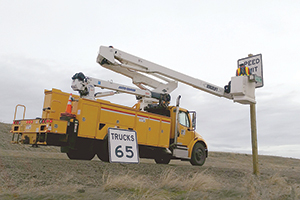Senior Reporter
Speed Limiter Proposal Expected Before Fall After Decade-Long Wait, FMCSA, NHTSA Say

This story appears in the July 25 & August 1 print edition of Transport Topics.
The pursuit of a heavy-truck speed limiter rule began in 2006 when American Trucking Associations and Road Safe America each filed petitions claiming that limiting the top speed of trucks would save both lives and fuel.
Although it’s been nearly a decade in the making, could a proposed rule finally be on the horizon?
The Federal Motor Carrier Safety Administration and National Highway Traffic Safety Administration, the prospective authors of a proposal, project the proposal is finally coming in “summer 2016.”
However, a NHTSA spokeswoman declined comment on the proposed rule, and an FMCSA spokesman did not respond to a request for comment by press time.
Typically, agencies list a specific date when they project their rulemakings, but if the past is any indicator of speed limiter rule projections — well, who knows when it’s coming?
Some industry insiders say privately they’re not even sure the proposed rule will be published before the upcoming presidential election, largely because agency projections have been pushed back more than 20 times. To add further mystery to the mix, the rule has been hung up at the White House Office of Management and Budget since May 2015, far beyond the typical 90 days allotted for OMB clearance.
Even some members of Congress have been frustrated with the delays. Included in the Senate version of the 2017 transportation funding bill is a provision calling on the U.S. Department of Transportation to advance a rule on speed limiters for trucks. Specifically, the legislation would give DOT six months to issue a final rule for which members of Congress and industry leaders have sought.
In April 2015, Transportation Secretary Anthony Foxx told members of Congress that the proposed rule would be out in the fall, and again in March, Foxx promised a rule by April.
That has only added skepticism that yet another deadline could pass again this summer.
Rob Abbott, vice president of safety policy for ATA, said the rule is coming but that he doesn’t know when. Abbott said the agency is holding up the proposal because of a need for “data in support of the cost-benefit analysis.”
“It is certainly not dead but will take a long while to pop out,” Abbott said.
The agency’s significant rulemaking report attributes the delay to “additional coordination necessary.”
Steve Owings, co-founder of Road Safe America, said he has grown “extremely frustrated” waiting for the proposal.
“It’s absurd that the OMB, which is supposed to be checking cost justification on a rule, to even take 90 days to justify this — which you’d think a bright 12-year-old could do,” Owings said. “We’re the only leading country without such a rule. OMB seems to be something of a black hole.”
Owings said that the Canadian provinces of Ontario and Quebec, which for years have required heavy trucks to be governed at the metric equivalent of 65 miles per hour, have been instrumental in a 24% reduction in crashes.
“That is right in line also with what happened in the U.K. and Australia,” he added.
But Todd Spencer, executive vice president of the Owner- Operator Independent Drivers Association, which opposes mandatory speed limiters, said the delay may not be a bad thing in the end.
“The rest of the story is that this could be an example of an agency doing the appropriate due diligence that it should do on every proposal,” Spencer said. “The fact that the proposal hasn’t gone anywhere has a whole lot to do with there not being any merit to it.”
Spencer added, “Limiting the productivity of commercial vehicles that are working under hours-of-service regulations on the absolute safest roads that we have in America is just simply lunacy.”


